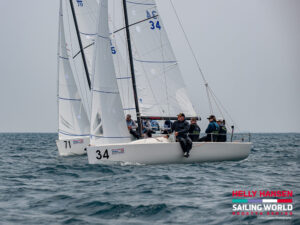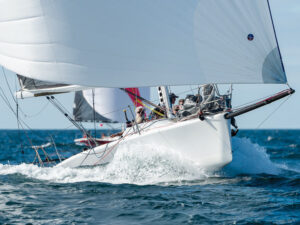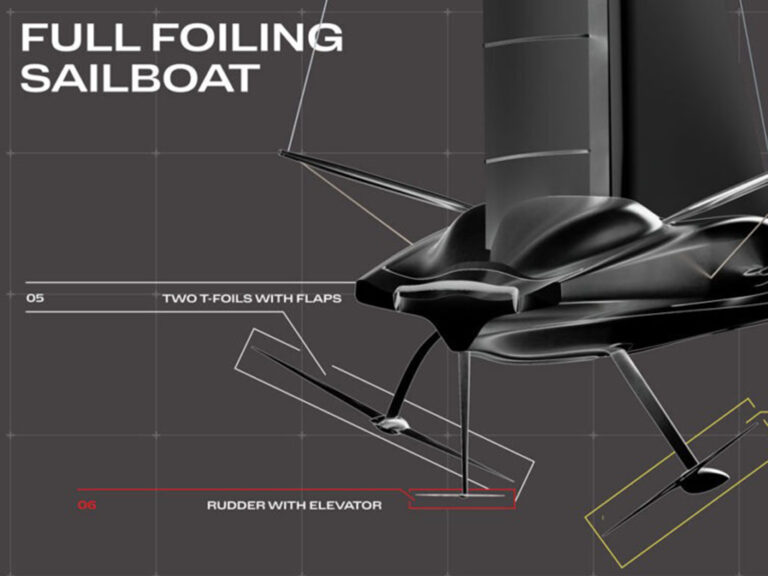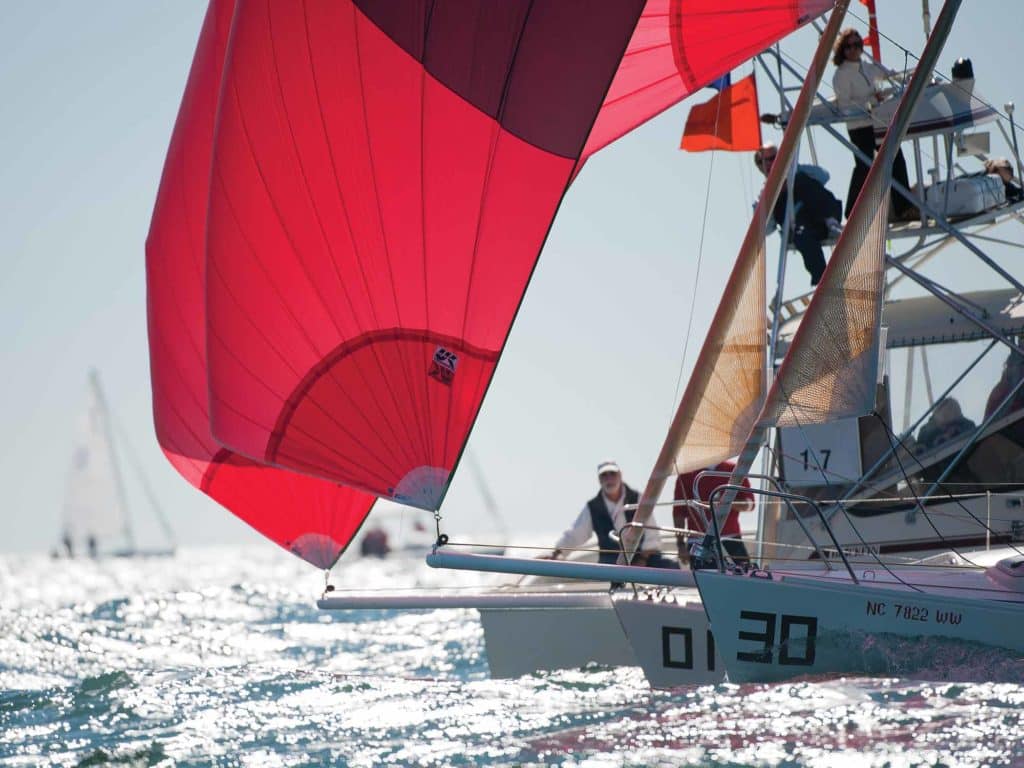
ν Downwind finishes used to mean squaring back the pole, sailing as perpendicular to the line as possible, keeping your air clear and crossing at the favored end. For boats with symmetric spinnakers, that’s still the norm. But if you sail a boat with an asymmetric spinnaker, the game has changed. True, you’re still looking for the favored end and working to keep your air clear, but you’re now sailing higher angles more parallel to the finish line, and jibing is expensive. There are also more interactions with other boats as people approach from different angles, so choosing a clear lane and getting the layline correct is more critical. On the macro level, treat a downwind finish line like a gate—come in from an edge, with a clear lane, and finish at the favored (upwind) end. With some boats, such as the J/70 and J/105, wing on wing into the finish also adds another dimension, allowing you to shoot the line. In addition to the general goals, it’s wise to know a few things that can go wrong and avoid them. Let’s look at some specifics.
Judging the Layline
Similar to approaching a gate, one way to pick a good layline to the finish is to make it easy on yourself. I have watched many great sailors pick an angle toward the finish that puts them about 50 to 100 yards outside the finish line. From this position, it’s a much easier one-and-in call for a precise layline to the finish. Another benefit of targeting that area from far away is that if you get a header as you sail toward the line, you don’t overstand. You just get closer to, or lay, the finish. And if you happen to get lifted or jibed on by another boat, you’re free to jibe and keep your options open.
It’s difficult to pick the layline from half a leg away, and even if you get it right, you have limited options to play shifts or jibe away if someone steels your breeze. It’s nice to have real estate to work with as you approach the finish line, especially in a shifty breeze where things are changing rapidly.
When it’s time to pick the short layline in and you see that someone might jump you on your final jibe into the finish, it often pays to jibe early, before layline, to force the interaction sooner. Doing so gives you options to jibe away if needed, or possibly hold for a little bit and jump them on the final jibe.
The Port-Tack Approach
One thing that can make your finish go very wrong is coming in near the port-tack layline (from the right side as you look downwind) and being forced to jibe by a starboard tacker. When doing so, anticipate any starboard tackers who might be heading your way. If you see a starboard boat that will intersect with you, slow down to go behind them rather than being forced to jibe. We often see these types of interactions about four to 10 boat lengths away from the finish, and the jibing port-tack boat usually loses huge. Besides slowing to sail behind the starboard tacker, the only thing that can save you is meeting them in the three-boat-length zone of the finish line. If this is the case, they owe you room to finish.
There are a couple of ways to handle the slowdown. The toughest situation is when you’re almost crossing, requiring you to make a big duck. In this case, it’s better to slow down early by bearing away and over-trimming the kite. Another method is to luff the kite, but the bear-away/over-trim is better, quieter, and it’s easier to get going when it’s time to reload and head up behind the starboard boat. For the reload, everyone needs to hike hard, and the main must be eased to sail behind them.
If the starboard boat is ahead and it’s a smaller duck, you might be able to just head up and go behind them without slowing down. In a big breeze, heading up and going behind someone can put you at risk of wiping out, so if it’s really nuking, slow down early, probably with a luff of the kite. Going low with a tight kite and then heading up in a huge breeze is tricky because the head-up-ease portion might cause you to wipe out. Sometimes, when slowing down to pass behind, the starboard boat will jibe, and that’s fine. Just follow them into the finish or, if they jibe late enough, you might be able to roll them on port.
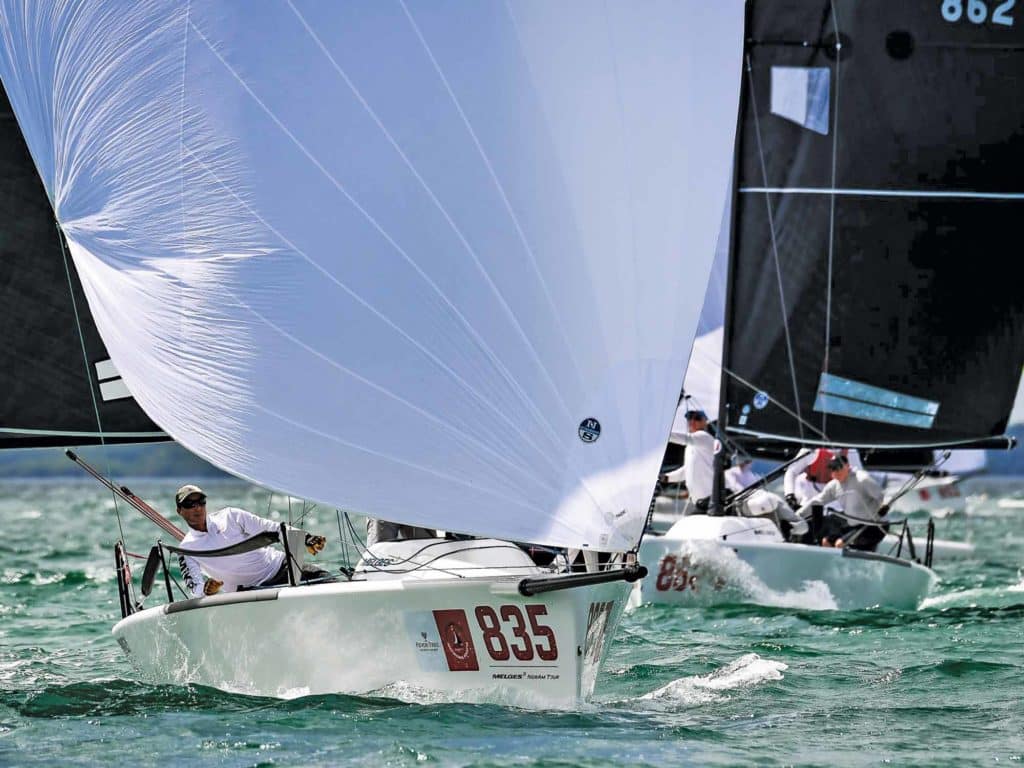
Winging It Across
I remember racing in the Helly Hansen Marblehead NOOD Regatta right before the Marblehead J/70 Worlds, and Tim Healy, a previous J/70 world champion, smoked us twice by winging into the finish in planing surfing conditions. Until then, I didn’t know that was an option in planing conditions. It was blowing around 15 knots, which is a low-plane mode in the J/70, and there were three to four boats coming into the finish line, all pretty close together. Both times, Healy bore away and winged the chute, shooting the line. While the rest of us were bow up and planing, he cut the corner and won the group each time. By sailing more perpendicular to the line in the final moments before finishing, he shaved valuable time off his race. It’s like shooting the upwind finish line by going head to wind and using your momentum to take the shortest path to the line.
How do you know if shooting the line by winging works best on your boat? My experience is, if you sail an asymmetric boat where a late-main jibe is fast, then wing into the finish if trying to beat nearby boats. A late-main jibe is when you bear away, pull the kite around, and hesitate with the main for a second while you’re going dead downwind. Then you throw the boom over and head up. Boats like J/70s and J/105s that have roller fuller jibs jibe that way and are prime candidates for winging. Boats that keep their jibs up all the time, like Vipers and skiffs, are not.
Of course, if you’re on a massive header and your course is somewhat perpendicular to the line anyway, don’t wing. But if you’re sailing an angle that’s a little more parallel to the line, you’re in prime winging conditions, and it’s probably faster than jibing. A jibe involves an 80-degree turn or so, while winging is closer to a 40-degree turn. The goal is to cross the line sailing at a 90-degree angle to it, so do whatever is right to make that happen.
Ideal conditions for winging into the finish line on a boat like a J70 are when the windspeed is around 7 to 17 knots. The light end of that range is not quite sustained winging conditions, so you must use momentum to make it work, and you might start your wing into the finish line as close as one to two boat lengths by winging the kite. If it’s breezier, you might already be on the wing; if you have marginal planing conditions, you can wing about three to five lengths away using the boom-over or kite-over technique.
If you have the luxury of picking the perfect layline into an end, I’ve found that most of the time race committees favor the pin end simply because they don’t want a bunch of sailboats anywhere near their nice committee boat.
There comes a point where it’s too breezy to wing to the finish line because, by doing so, you’ll wipe out. We prefer to always douse the kite on the port side of the boat, and we were on port-tack, so the main and the kite were on the starboard side. Once, in one race in 20 knots, we said, “Let’s bear away, wing the kite and douse it.” We bore away, pulled the kite over, and boom! Death roll to windward with everyone hanging from the stanchions—it went bad really quickly and all we could do was laugh. Luckily, we had it on our GoPro and got more laughs out of it later. That’s why I picked 17 knots as a top-end number for winging into the finish, and at that point, it’s probably best to wing the boom for a less violent “pop” of the sail.
At some point in big breeze, you’re going so fast that it doesn’t make sense to wing. You’ll be planing at such a high speed, you’ll just rip right through the line. Plus, as it gets windier and windier, you’re actually planing pretty low—sailing fairly deep. And the fleet’s usually pretty spread out, so you can just rip through the finish line.
Choosing the Favored End
I’ve found spotting the favored end of the downwind finish to be fairly difficult. It’s easier to choose the favored end at a gate because the marks are the same size. But at a finish line, the ends are a big RC boat and small mark, which makes spotting the “bigger” mark to determine the bias doesn’t work. If there’s a flag on the pin, it will always point upwind toward the favored end. But don’t trust flags on a committee boat, unless the flag is well above the boat. Big boats tend to skew the wind. In either case, it’s difficult to see a flag unless you’re really close, especially from upwind.
The most important thing is to sail fast and have a clear lane all the way through the line. And, as mentioned earlier, if winging makes sense, do so. Having said all that, if you have the luxury of picking the perfect layline into an end, I’ve found that most of the time race committees favor the pin end simply because they don’t want a bunch of sailboats anywhere near their nice committee boat.
If you’re midfleet and it’s going to be a photo finish with a group of boats, just like the gate, it pays to be on an edge, ideally right in the race committee’s face. This is true for all boats. It’s tough for them to write down numbers of a lot of boats all finishing at once. Boats that are blocking the rest of the fleet from their view inevitably get scored ahead.
On the final downwind, close to the finish line, I’m always looking around and constantly asking myself, How can I keep a lane all the way in and how do I minimize maneuvers? I always want to do one-and-in. If you can satisfy those requirements—one-and-in and a big lane—you have everything working for you to give you a great finish.


